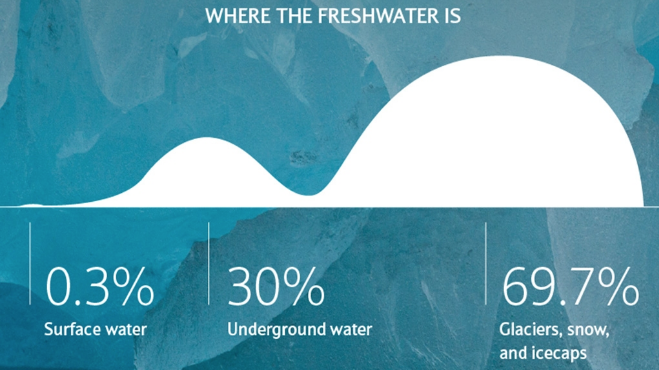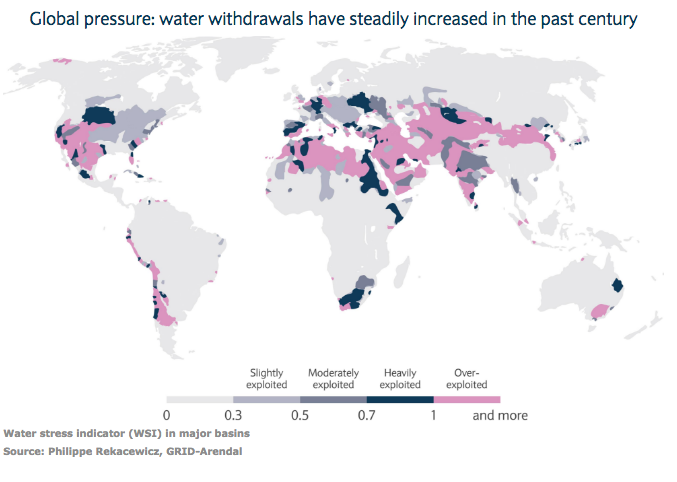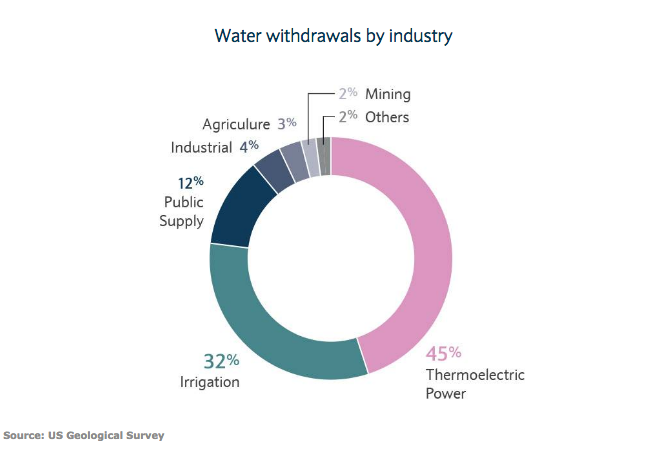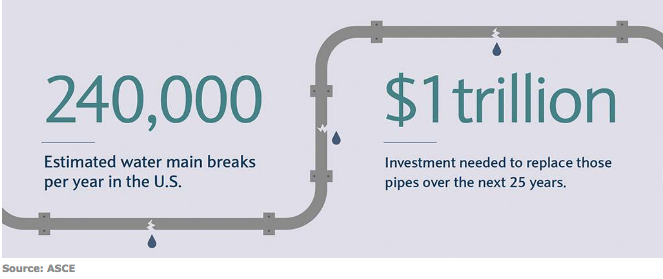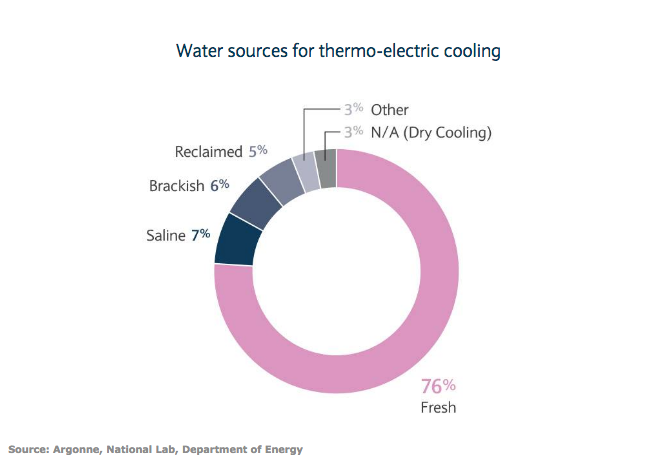Barclays Analysis: Rising to the Water Challenge
From Barclays and Columbia Water Center
Water is undoubtedly one of the most precious natural resources for life on earth. Without access to good quality freshwater, human, animal and plant survival is impossible, while many industries are also highly dependent on reliable sources of water for their day-to-day operations and long-term viability.
However, factors such as climate variability, droughts, growing populations and economic expansion are all placing greater demand on the available water sources.
The extent of the water problem is starkly illustrated by the data: only 2.5% of the world’s water is fresh1, yet the US depends on it for nearly 90% of withdrawals for public and industrial use2. At the same time, groundwater, which makes up 30% off all freshwater, is under widespread stress, with NASA reporting that a third of major water basins globally are being rapidly depleted by human consumption.3
To counter these stresses, the challenge for individuals, governments and industry is to embrace sustainable practices, technologies and policies to ensure the preservation of this global resource.
1Source: Food and Agriculture Organization of the United Nations
2Source: US Geological Survey
3Source: NASA
A ripple effect on society and the environment
Water scarcity has a direct effect on public health, availability of food and, ultimately, public safety. In an increasingly interlinked world, with ever-expanding trade routes, water stress in one geographic region not only affects local populations, it can also have a reverberating impact in other regions.
In agriculture, for example, a shock such as a drought or blight (a fungal disease that spreads rapidly in wet weather) can have a high human cost through famine, but also global implications for food supplies. Countries that import water are especially vulnerable to such shocks.
What are the water challenges for the energy industry?
Energy companies – in particular, the oil and gas industry, and electric and water utilities - use substantial amounts of water and have an important role to play in protecting resources.
Oil and gas
In the U.S. oil and gas industry, for example, fracking operators have increased their use of freshwater from 5,600 barrels per oil well in 2008 to more than 128,000 barrels in 2014, and over 300,000 barrels in some areas today. Although the industry is improving the way it deals with wastewater, it has been responsible for spillages and other problems.
Power utilities
Electric utility companies withdraw a lot of water for cooling purposes, although much of this is returned to the water cycle. However, in water-stressed regions, these withdrawals may contribute to supply and demand imbalances. The problem lies not so much in contributing to water scarcity as protecting against it.
Water utilities
Water companies have different water constraints from oil and gas operators. The sector is typically publicly owned, with less access to capital to invest in ageing infrastructure and innovative solutions to counter water loss and leakages. Its main challenges include a decline in supply and an increased demand for freshwater.
And what are the possible solutions?
Despite differences between the oil and gas sector, electricity providers and water utilities, there are opportunities for them to collaborate through shared learning and innovation. For example, larger, well-capitalised companies in the oil and gas industry, as well as some utilities, can help finance upgrades for capital-constrained small public wastewater utilities in exchange for use of wastewater.
Oil and gas operators
Through a combination of reusing and recycling wastewater and applying innovative technologies, it has been predicted that oil and gas operators could substantially increase reused water for operating oil and gas wells. These companies could also look to use treated brackish water (a naturally occurring mix of fresh and salty water) instead of freshwater.
Reuse: Defined as wastewater that is used within an oil or gas well, requiring very little additional treatment, reuse could lower water-related costs by about 45% and save over 300,000 barrels of freshwater per well.
Recycling: Recycling is treating wastewater to acceptable standards through robust treatment technologies that range from simple filtration, which removes large organic particles, and oil and gas bubbles, to complex procedures that treat water to near freshwater standards. There are many possible uses for recycled wastewater, especially for livestock watering and crop irrigation.
Many factors dictate whether reuse and recycling are viable options for oil and gas companies. Cost, water availability, water quality logistics, and disposal options all have a bearing on whether an operator reuses or recycles.
Electric utilities
Power companies can reduce the amount of freshwater they use by turning to saline and recycled municipal water instead. They can also deploy demand-side management and energy efficiency. Like the oil and gas sector, alternative water sources used with additional treatment can be an opportunity, but they also require additional infrastructure, and are costly and energy intensive.
Water utilities
As water scarcity continues to limit existing freshwater supplies, water utilities are looking at alternatives to freshwater sources, including treated brackish, saline and wastewater. Other solutions include managing existing supplies through conservation, smart water management and leak detection technologies.

